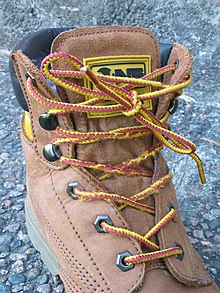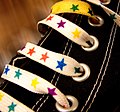Lace up
A type of eyelet is referred to as a lace-up loop , which is used primarily to close shoes , but also items of clothing and other materials by means of what is known as lacing . Lacing eyelets reinforce the holes in the respective materials required for the lacing and reduce the risk of tearing. They are made of metal or plastic and are known in various forms, mostly ring-shaped and, to a lesser extent, hook-shaped eyelets are used.
When used in shoes, the term shoelace eyelet is sometimes used .
principle
Lace-up eyelets must always be present in pairs in the two pieces of shoes or clothing etc. to be connected in order to allow lacing at all, and are therefore usually arranged opposite one another.
When lacing, it is closed with the help of straps or cords that are passed alternately through the eyelets, such as, for example, in shoes with one laces for each individual shoe.
history
Due to the tensile forces that occur, holes in shoes, clothing, leather and other materials that are designed for the purpose of closing often run the risk of tearing. The frequency with which the laces are made, the constant and changing loads when wearing laced shoes or items of clothing, etc., and their material properties and thickness also play a role here. The “lacing holes” were therefore equipped early on with material reinforcements and textile edge reinforcements similar to buttonholes . In 1828, metal eyelets were invented, which were initially mainly used for corsets .
In the course of the emerging industrialization, from around the middle of the 19th century both the development of special punching machines for the production of lace eyelets and the production and sale of lace eyelets as regular merchandise by manufacturers took place, which was achieved through participation in exhibitions such as the General German Trade Exhibition 1844 in Berlin or at the world exhibition of 1873 in Vienna .
In the past, the term Öllet , which is based on the French term œillet métallique, was sometimes used for lace-up eyelets , especially in the Rhenish language and as a technical term for the band knitter.
Lace-up eyelets are mostly designed and used in ring shape and sometimes also in hook shape (so-called "shoe hooks"); other special forms are rather rare. They must be tailored to both the shoes or items of clothing, etc. to be closed, as well as the straps or cords provided, such as the laces that match the shoe. This applies above all to the shape and size of the eyelets, especially the inside diameter, as well as their surface properties, durability and long-term load capacity. There is no standardization of lace-up eyelets; However, some standard shapes, sizes and colors have emerged depending on the manufacturer and specialist trade needs.
use
Nowadays , lace-up eyelets are mainly used for lace-up shoes and boots that are closed by lacing with shoelaces. They can also be found in tied connections on body-shaping garments that have to withstand great tensile force, such as bodices and corsets, as well as in lacing, which is usually used as a visual accent in traditional clothing , traditional fashion and other outer clothing.
Lace-up eyelets are also used for other purposes in which the connection and cohesion of or with mostly flexible fabrics are made by means of lacing, such as for cover and truck tarpaulins or tent sheets .
Trivia
Elegant lace-up shoes, especially in a man's wardrobe, include eyelets, never hooks, in a color that matches the upper leather. Hooks are very popular on shoes and boots because of their quick handling (there is no need to thread them in or out). However, hooks can also cause injuries and there is also a risk of them getting caught in lines or cords. Boots for skydivers always have laces instead of hooks. Boots for fishermen (nets!) And anglers also have better eyes than hooks.
A well-fitting lace-up shoe or boot can be recognized by the fact that after the lacing, the rows of lace-up eyelets run parallel to each other, as the upper material of the shoe then precisely encloses the foot .
Ring eyelets at loafers brand Doc Martens
American combat boot with two differently shaped eyelets
Ready-to-use laced shoes with parallel rows of lacing eyes (here with a pair of chucks)
Metal lace eyelets were first used in corsets (here on a patented US model from 1907)
Ring-shaped eyelets on a bodice with decorative lacing
Mountain boots , one open and one laced
Individual evidence
- ↑ See Amand. Ferd. Neukrantz (Hrsg.): Detailed report on the large general German trade exhibition in Berlin in 1844. M. Simion, Berlin 1845, p. 169 ( excerpt from Google Books ).
- ↑ a b See official catalog of the exhibition of the German Reich. Vienna World Exhibition 1873 . Königliche Geheime Oberhofbuchdruckerei (R. v. Decker), Berlin 1873, pp. 396–397 ( excerpt from Google Books ).
- ↑ Cf. entry on Öllet in: Rhenish Dictionary , Volume 6 (N - Q), 1941–1944, p. 398 ( online ).
- ↑ See Urs Weber: Equipment manual for runners. Meyer & Meyer, Aachen 2009, ISBN 978-3-89899-456-9 , p. 39 ( excerpt from Google Books ).








